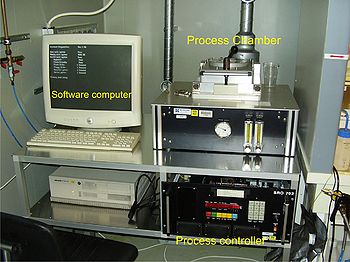Specific Process Knowledge/Thermal Process/BCB Curing Oven: Difference between revisions
No edit summary |
|||
| Line 7: | Line 7: | ||
[[image:BCB oven.jpeg|350x350px|right|thumb|The BCB Curing Oven. Positioned in the A-4 room]] | [[image:BCB oven.jpeg|350x350px|right|thumb|The BCB Curing Oven. Positioned in the A-4 room]] | ||
The BCB Curing Oven is mainly used for curing of BCB (bisbenzocyclobutene) and for alloying of metals in a nitrogen atmosphere. | The BCB Curing Oven is mainly used for curing of BCB (bisbenzocyclobutene) and for alloying of some metals in a nitrogen atmosphere. | ||
During processing the | During processing the oven is rapidly heated by use of eight halogen lamps situated below the sample. The maximum allowed temperature is 450 <sup>o</sup>C. | ||
The | |||
The oven is purged with a nitrogen flow (high or low flow). Samples are processed at atmospheric pressure or at vacuum. | |||
| Line 21: | Line 22: | ||
Here are some of the standard processes used in the BCB Curing Oven. | Here are some of the standard processes used in the BCB Curing Oven. | ||
=== BCB curing | === BCB curing=== | ||
An example of a curing recipe (BCB250BL.PDF) for a long curing process at 250°C is shown below. | |||
Content of BCB250BL.PDF: | Content of BCB250BL.PDF: | ||
<pre> | <pre> | ||
; | ; | ||
| Line 48: | Line 48: | ||
</pre> | </pre> | ||
===General processes=== | ===General processes=== | ||
There are a number of general processes named DxxxCyyy.PDF. | There are a number of general processes on the oven named DxxxCyyy.PDF. | ||
The Dxxx is the set temperature (in °C) and the Cyyy is the time (in minutes) at the set temperature. | The "Dxxx" in the recipe is the set temperature (in °C) and the "Cyyy" is the time (in minutes) at the set temperature. | ||
The oven heats to the set temperature (xxx) in 5 mins and then stays at the temperature (xxx) for a time (yyy) after which it cools to room temperature as fast as possible. | The oven heats to the set temperature (xxx) in 5 mins and then stays at the temperature (xxx) for a time (yyy), after which it cools to room temperature as fast as possible. | ||
The program sequence looks like this for the file D200C060.PDF: | The program sequence looks like this for the file D200C060.PDF: | ||
| Line 84: | Line 83: | ||
|style="background:LightGrey; color:black"|Temperature | |style="background:LightGrey; color:black"|Temperature | ||
|style="background:WhiteSmoke; color:black"| | |style="background:WhiteSmoke; color:black"| | ||
* | *Room temperature - 450<sup>o</sup>C | ||
|- | |- | ||
|style="background:LightGrey; color:black"|Nitrogen flows | |style="background:LightGrey; color:black"|Nitrogen flows | ||
| Line 111: | Line 110: | ||
*Quartz | *Quartz | ||
*Resist (prebaked) | *Resist (prebaked) | ||
* | *Metals (only Al, Ni, Ge and Au) | ||
|- | |- | ||
|} | |} | ||
Revision as of 13:46, 3 February 2020
Feedback to this page: click here
BCB Curing Oven

The BCB Curing Oven is mainly used for curing of BCB (bisbenzocyclobutene) and for alloying of some metals in a nitrogen atmosphere.
During processing the oven is rapidly heated by use of eight halogen lamps situated below the sample. The maximum allowed temperature is 450 oC.
The oven is purged with a nitrogen flow (high or low flow). Samples are processed at atmospheric pressure or at vacuum.
The user manual, user APV, technical information and contact information can be found in LabManager:
Process information
Here are some of the standard processes used in the BCB Curing Oven.
BCB curing
An example of a curing recipe (BCB250BL.PDF) for a long curing process at 250°C is shown below.
Content of BCB250BL.PDF:
;
; stored 31.08.2011 at 17:55:33
{P0}
00,00:30,0020,- - - - 3 - - - -,075,250,001,005,028
01,00:10,0020,- - - 2 - - - - -
02,00:30,0020,- - - - 3 - - - -
03,00:10,0020,- - - 2 - - - - -
04,05:00,0050,H - - 2 - - - - -
05,05:00,0050,H C - 2 - - - - -
06,15:00,0100,H - 1 - - - - - -
07,45:00,0100,H C 1 - - - - - -
08,15:00,0150,H - 1 - - - - - -
09,81:00,0150,H C 1 - - - - - -
10,60:00,0250,H - 1 - - - - - -
11,60:00,0250,H C 1 - - - - - -
12,15:00,0020,- C 1 - - - - - -
13,30:00,0020,- C 1 - - - - - -
14,00:00,0010,- C - - - - - - -
General processes
There are a number of general processes on the oven named DxxxCyyy.PDF.
The "Dxxx" in the recipe is the set temperature (in °C) and the "Cyyy" is the time (in minutes) at the set temperature.
The oven heats to the set temperature (xxx) in 5 mins and then stays at the temperature (xxx) for a time (yyy), after which it cools to room temperature as fast as possible.
The program sequence looks like this for the file D200C060.PDF:
;
; stored 31.08.2011 at 18:15:47
{P0}
00,05:00,0200,H - - 2 - - - - -,075,250,001,005,028
01,60:00,0200,H C 1 - - - - - -
02,05:00,0002,- C 1 - - - - - -
03,00:00,0000,- C - - - - - - -
| Equipment | BCB Curing Oven | |
|---|---|---|
| Purpose |
| |
| Process parameter range | Temperature |
|
| Nitrogen flows |
| |
| Pressure |
| |
| Substrates
(Remember to use the right carrier wafer) |
Batch size |
|
| Allowed materials |
| |
